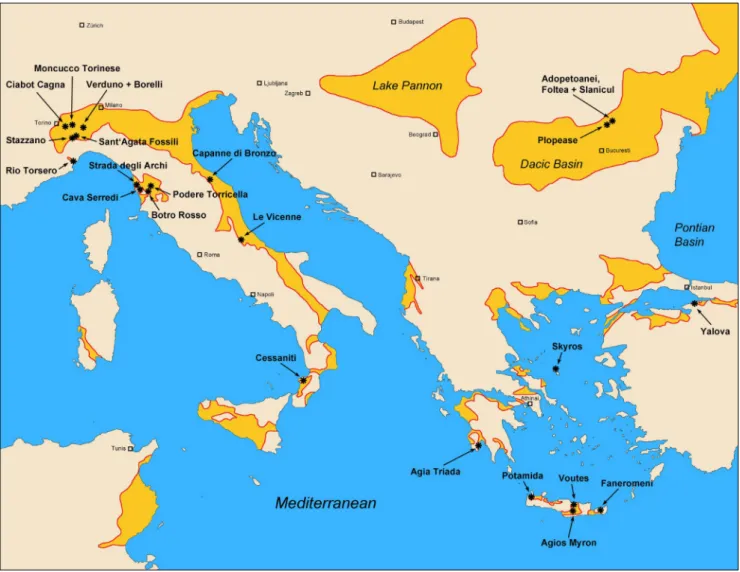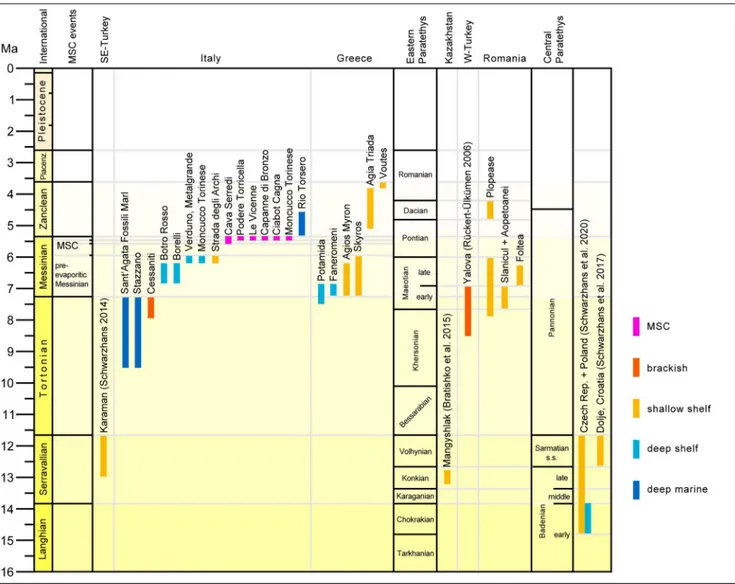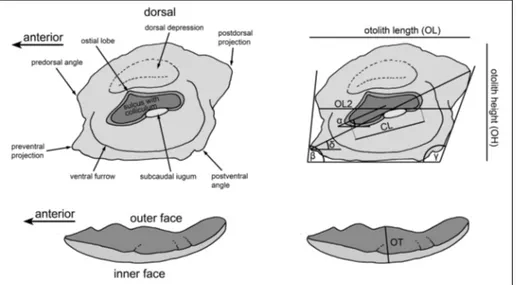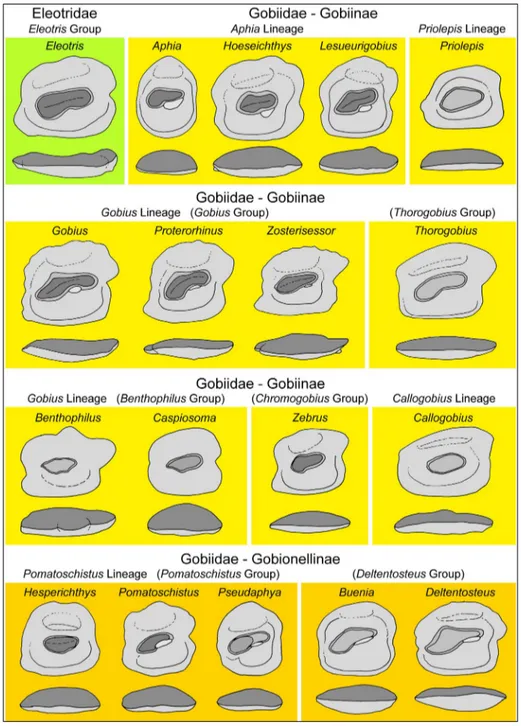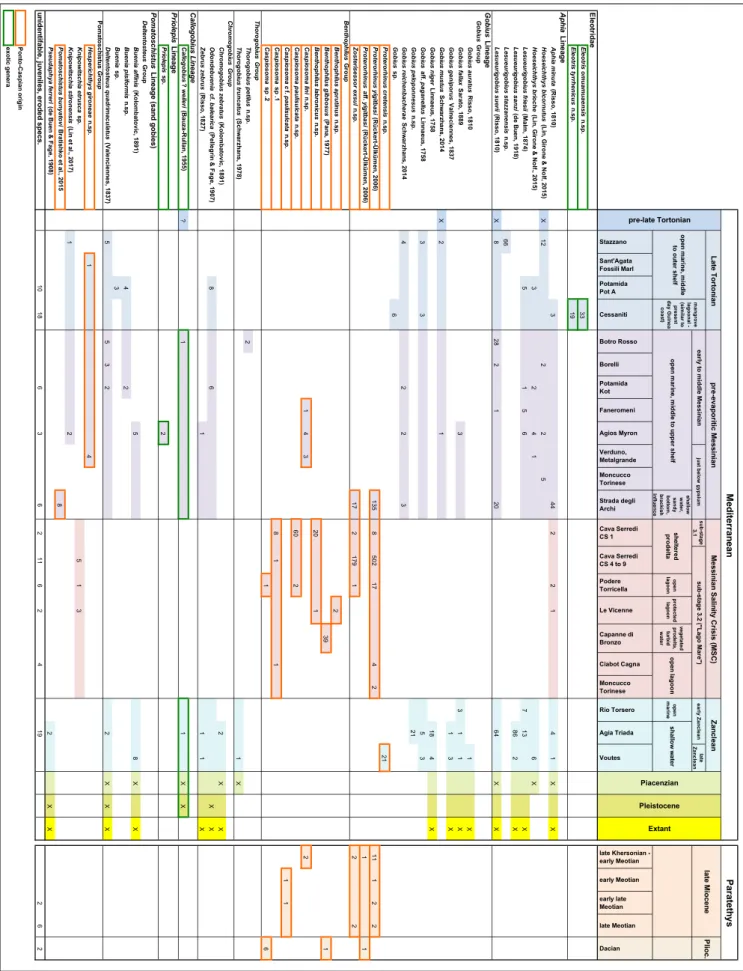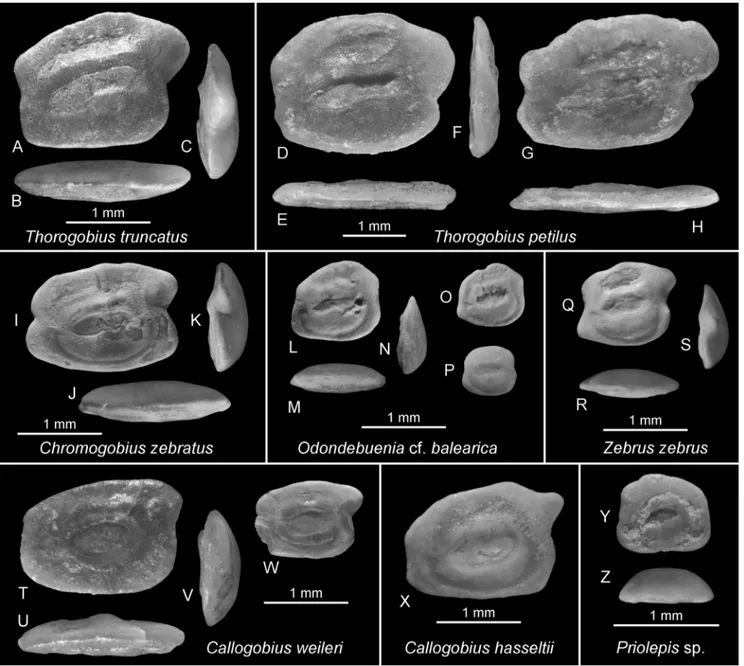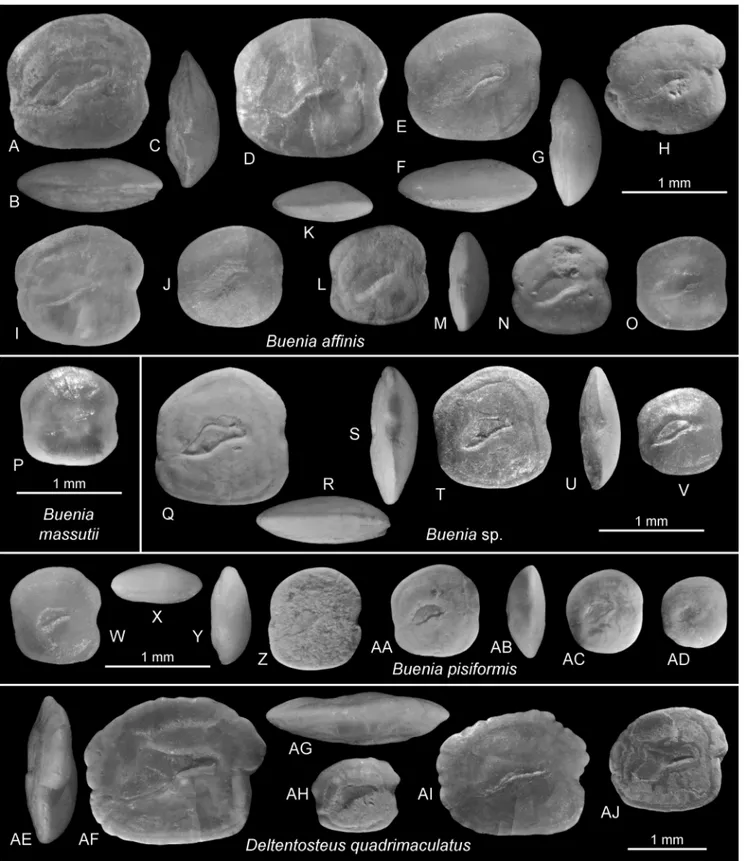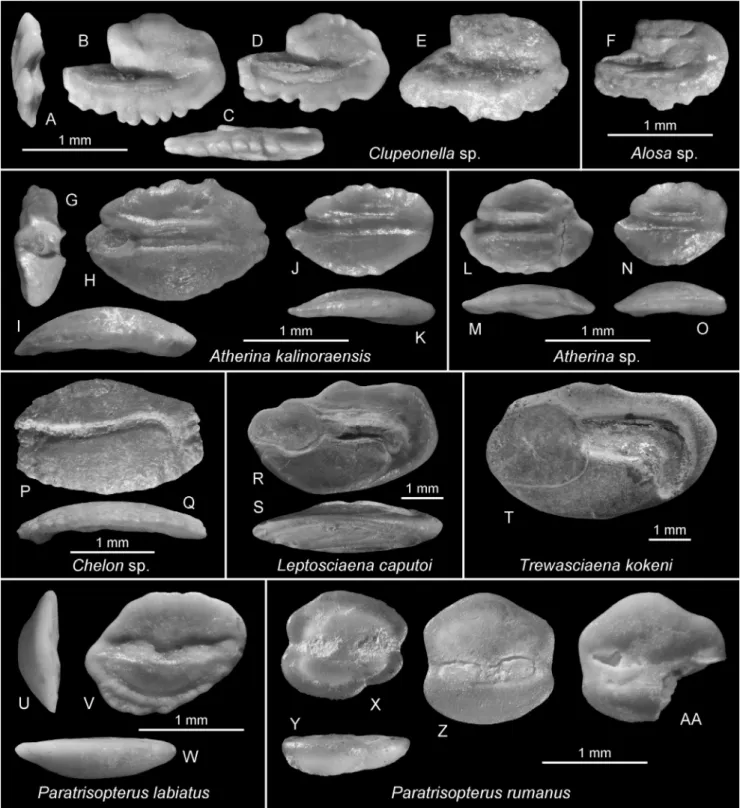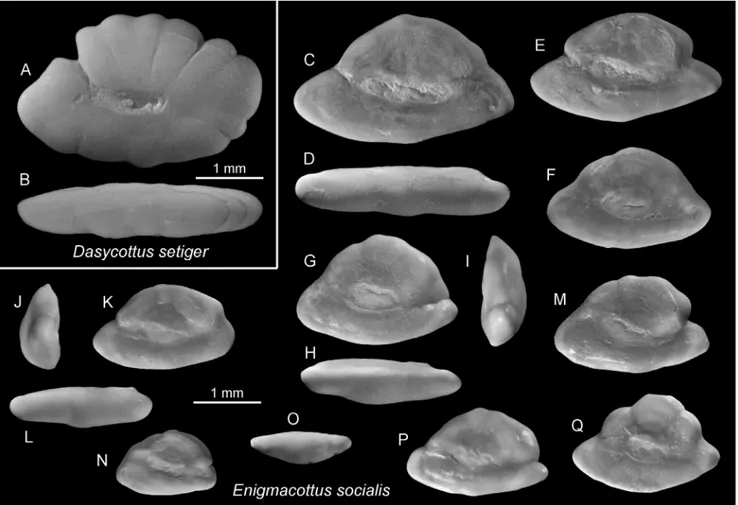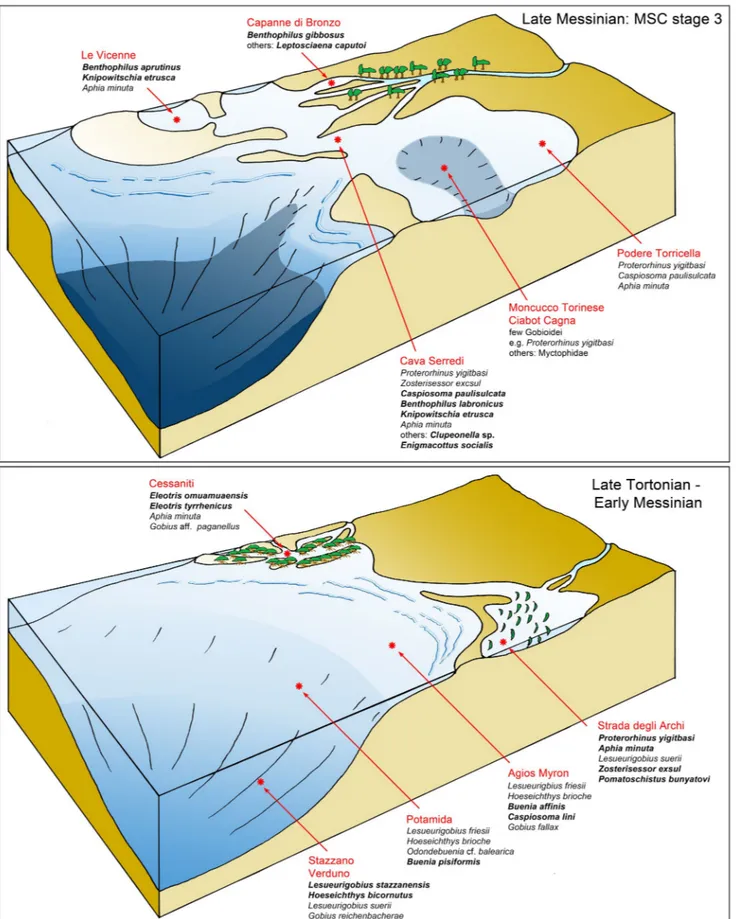LATE MIOCENE–EARLY PLIOCENE EVOLUTION OF MEDITERRANEAN GOBIES AND THEIR ENVIRONMENTAL AND BIOGEOGRAPHIC SIGNIFICANCE
WERNER SCHWARZHANS1*, KONSTANTINA AGIADI2 & GIORGIO CARNEVALE3
1*Corresponding author. Natural History Museum of Denmark, Zoological Museum, Universitetparken 15, 2100 Copenhagen, Denmark.
E-mail: [email protected]; http://orcid.org/0000-0003-4842-7989.
2Department of Historical Geology and Paleontology, Faculty of Geology and Geoenvironment, National and Kapodistrian University of
Athens, Panepistimioupolis, 15784, Athens, Greece. E-mail: [email protected]; http://orcid.org/0000-0001-8073-559X
3Dipartimento di Scienze della Terra, Università degli Studi di Torino, Via Valperga Caluso 35 10125 Torino, Italy.
E-mail: [email protected]; http://orcid.org/0000-0002-3433-4127.
To cite this article: Schwarzhans W., Agiadi K. & Carnevale G. (2020) - Late Miocene–Early Pliocene evolution of Mediterranean gobies and their environmental and biogeographic significance. Riv. It. Paleontol. Strat., 126(3): 657-724.
Abstract. The Lago Mare phase at the end of the Messinian Salinity Crisis (MSC) in the Mediterranean has
long been known for the Paratethyan affinities of its biota. The taxonomic level of these affinities and their origin, however, is subject to divergent interpretations. Here, we have studied otoliths of the Gobioidei from late Miocene and early Pliocene deposits from Italy and Greece and revised earlier studies including time-equivalent data from Ro-mania and NW Turkey. Nowadays, gobies constitute the most speciose marine fish family in Europe and the most di-verse endemic family in the Ponto-Caspian region. Furthermore, they are highly adapted to nearshore shallow marine, brackish, and freshwater environments, which makes them excellent candidates to explore short-term connections of waterways of different nature.
The normal marine late Tortonian and pre-evaporitic Messinian deposits of the studied Italian and Greek locations contained a rich and diverse goby assemblage, but species with Paratethyan affinities were very rare and pos-sibly originated from connections during the early Serravallian (late Badenian) and early Messinian (early Meotian). A rare fauna from a paralic environment from Cessaniti, Calabria, similar to the mangrove environments found in the present-day Guinea coastal area, revealed two species of the family Eleotridae and no gobies with Paratethyan affinities. Cessaniti provides a unique opportunity to recognize the presence of this type of environmental context with a unique gobioid assemblage in the Neogene of Europe. The shallow-water brackish-influenced sediments of Strada degli Archi just below the MSC show an increasing influence of Paratethyan gobiid taxa (Proterorhinus yigitbasi, Zosterisessor exsul n.
sp.), which are not present in time-equivalent normal marine environments, but have also been identified in the Dacic Basin of Romania. Sediments of the stage 3 ot the MSC, especially those that accumulated during the Lago Mare event, were dominated by a diverse goby assemblage with Paratethyan affinities, while indigenous Mediterranean goby taxa disappeared probably because of the lack of suitable conditions for neritic demersal stenohaline fishes, except for the nektonic Aphia minuta. The sediments of the stage 3 of the MSC also included in one particular location and level the
unusual Enigmacottus socialis n. gen., n. sp., a putative member of the family Psychrolutidae of uncertain origin, which
constitutes about 70% of all otoliths obtained from that interval in Italy. Beginning with the Zanclean, the goby assem-blage of the Mediterranean shows an almost exclusively Atlantic-Mediterranean composition.
A total of 15 new species are described, 12 in the family Gobiidae, two of the Eleotridae, and one
puta-tive Psychrolutidae. The new taxa are: Eleotris omuamuaensis n. sp., Eleotris tyrrhenicus n. sp., Lesueurigobius stazzanensis n.
sp., Gobius peloponnesus n. sp., Proterorhinus cretensis n. sp., Zosterisessor exsul n. sp., Benthophilus aprutinus n. sp., Benthophilus labronicus n. sp., Caspiosoma lini n. sp., Caspiosoma paulisulcata n. sp., Thorogobius petilus n. sp., Buenia pisiformis n. sp., Hespe-richthys gironeae n. sp., Knipowitschia etrusca n. sp., and Enigmacottus socialis n. gen. et n. sp.
Received: June 6, 2020; accepted: July 29, 2020
I
ntroductIonThe terminal Miocene events in the Mediter-ranean have been the topic of many decades of re-search that has resulted in a large number of publica-tions, some containing divergent or even conflicting hypotheses of what happened during the Messin-ian Salinity Crisis (MSC) and in particular during its latest phase, the Lago Mare Event, before the re-establishment of a normal marine regime with the onset of the Pliocene. The Lago Mare Event is commonly considered as characterized by non-ma-rine deposition in the Mediterranean, commonly at-tributed to the capture of brackish waters from the Paratethys during a very humid phase, which led to the formation of giant brackish or lacustrine basins (lake-seas or Lago Mare) on the desiccated deep floor of the Mediterranean before its re-connection with the Atlantic Ocean through the opening of the Strait of Gibraltar at the beginning of the Pliocene (Cita et al. 1978; Hsü 1984; Orszag-Sperber 2006; Roveri et al. 2014). The brackish nature of the Lago Mare waters and their Paratethyan derivation have been primarily hypothesized based on the assump-tion that the common brackish ostracods, mollusks, and dinocysts of Paratethyan affinities found in the Lago Mare deposits migrated into the Mediterrane-an Sea from the Paratethys during that time (Grothe et al. 2018). However, a series of recent studies pro-vide new perspectives on the concepts of the Med-iterranean desiccation during the MSC and the sub-sequent Lago Mare phase (Roveri et al. 2009, 2014, Harzhauser et al. 2015; Marzocchi et al. 2016; Car-nevale et al. 2018, 2019; but see Garcia-Castellanos et al. 2020). Nevertheless, many aspects of the late Miocene evolution of the Mediterranean basin and the nature and diversity of its aquatic ecosystems remain underexplored and elusive, thereby repre-senting some of the most interesting geological and paleobiological topics of Cenozoic history.
One of the main limiting factors for the comprehensive understanding of the Lago Mare bi-otic structure is the scarcity and poor knowledge of shallow marine sediments of Tortonian, pre-evap-oritic Messinian and Zanclean in the Mediterrane-an, since well-studied outcrops are dominated by pelagic sediments containing oceanic faunas. This lack of knowledge has so far limited the compar-ison of the Lago Mare fauna with preceeding and subsequent ecologically equivalent Mediterranean
faunal assemblages. Here, we have the opportunity to evaluate the largest known collection of otoliths from the Lago Mare interval from various locations and environmental settings in Italy and compare it with otoliths obtained from newly sampled late Tortonian, pre-evaporitic Messinian and Zanclean shallow-water sediments from Italy and Greece. Our focus in this study is on gobioid otoliths as well as on other teleost groups that could be of interest for elucidating relationships with Paratethyan fish faunas. We describe previously unreported materi-al, and we review the previously published otolith record of gobioids and other relevant groups. Spe-cifically, we review otoliths from the Lago Mare sediments of Italy (Caputo et al. 2009, and Car-nevale et al. 2006a, b, 2008, 2018), the late Miocene and early Pliocene of Greece (Agiadi et al. 2013a, 2017, 2020), the pre-evaporitic Messinian of Italy (Girone et al. 2010) and, the Meotian and Dacian of Romania (Pana 1982b, 1995). We recognize 45 gobioid species (43 in the family Gobiidae and 2 belonging to the family Eleotridae) from this time interval, including 14 new species and 5 left in open nomenclature. In addition, we describe a new genus and species (Enigmacottus socialis n. gen, n. sp.) and
tentatively assign it to the family Psychrolutidae, based on very abundant material almost exclusively known from a single fossiliferous layer of the Cava Serredi succession in Tuscany.
Gobies are of particular interest for a num-ber of reasons. They are highly diverse, highly adapted to nearshore shallow marine and brackish environments, but also occur in freshwaters. The Ponto-Caspian gobies represent the largest diversity of endemism of any teleost group of that region. Some of them are remarkably euryhaline and suc-cessful migrators and colonizers of new biotopes (Dillon & Stepien 2001; Jacobs & Hoedemakers 2013), a powerful combination that makes gobies excellent candidates to explore short-term con-nections of waterways of different nature. Other members of this group are indicative of very spe-cific environmental conditions. Goby otoliths are often dominant in shallow marine and transitional marine-brackish sediments since the early Miocene, while the group is generally rare in the Paleogene. The rich otolith record documents that the main phases of goby radiation seem to have occurred in the late Neogene, which is consistent with the tim-ing of diversification derived from molecular
stud-ies (Thacker et al. 2018). Furthermore, gobstud-ies are known for their ability to rapidly adapt under eco-logic stress (Rüber et al. 2003; Yamada et al. 2009; Patzner et al. 2011). In fact, most of the evolution of the endemic Ponto-Caspian goby stock seems to have been linked to the separation of the Para-tethys from the Mediterranean since the Serravalli-an (Bratishko et al. 2015, 2017; SchwarzhSerravalli-ans et al. 2015, 2017, 2020; Schwarzhans 2014, 2017). Thus, occurrence of Paratethyan goby taxa in the Med-iterranean would indicate the existence of direct connection with the Paratethys after the Langhian, thereby reinforcing previous hypotheses on several episodic connections established between the two basins during times of the late Miocene (e.g., Popov et al. 2006; van Baak et al. 2016; Palcu et al. 2019; Grothe et al. 2020).
The fishes of the family Gobiidae repre-sent the teleost family with the highest degree of
diversity in the waters of Europe (Froese & Pauly 2019). About 70 gobiid species inhabit the Atlan-tic-Mediterranean faunal province of Europe (Fro-ese & Pauly 2019), and 47 species occupy a varie-ty of biotopes of the Ponto-Caspian Basin (Miller 2003, 2004). A recent study of Badenian goby oto-liths from the Central Paratethys (Schwarzhans et al. 2020) demonstrates that a highly diverse goby assemblage was established in that area as early as at least the middle Miocene. A total of 20 goby species were identified from the early Badenian (= Langhi-an) at a time when the Central Paratethys and the Mediterranean were fully connected marine basins. This assemblage did not contain any persistent Pon-to-Caspian taxa, which first occur in the late Bade-nian (= early Serravallian). In the Serravallian (late Badenian and Sarmatian s.s.) 34 goby species have been identified in the Paratethys (Bratishko et al. 2015; Schwarzhans et al. 2015, 2020; Schwarzhans
Fig. 1 - Location map of sampled localities used for this study. Late Miocene to early Pliocene basin outlines in onshore terrain marked by yellow color and red frame, simplified and schematized after Asch (2003) and Compagnoni & Galluzzo (2005).
2017). Moreover, nine goby species were found in the Serravallian shallow-water sediments in south-eastern Turkey (Schwarzhans 2014). The otolith assemblages from the late Sarmatian s.l. / Meotian (=late Tortonian) to the Dacian (= late Zanclean) described by Pana (1982b, 1995) from Romania and by Rückert-Ülkümen (1992, 1993, 1996, 2006) from the Marmara region in Turkey have been reviewed as far as possible based on original material and assessment of the documentation in their publica-tions. Otoliths of nearly 100 extant European goby species and more than 600 extant gobioid species from more than 235 genera from a worldwide ba-sis have been available for comparison. These data form the basis for the assessment of the 45 gobioid otolith-based species now recognized from the late Miocene and early Pliocene of the Mediterranean. This aggregated and almost continuous database provides for a first detailed assessment of the evo-lution of European gobioid fishes in the Mediterra-nean throughout the late Neogene, their interaction with the Paratethys, and the recognition of gobioid lineages, which are now extinct in Europe.
We recognize that the taxonomic identifica-tion and definiidentifica-tion of gobiid otoliths is difficult due to the recurrent and possibly convergent morpho-logical features within the otherwise easily recogniz-able general gobioid otolith pattern. Identification of gobioid otoliths is further hampered by varying degrees of intraspecific morphological variability and the abundance of small, sometimes pedomor-phic species with otoliths that are difficult to be distinguished from those of juvenile individuals of large-sized species. These observations associated with the limited knowledge of extant gobioid oto-lith morphologies have often led previous otooto-lith researchers to leave many fossil otolith-based taxa in open nomenclature.
G
eoloGIcal settInGThe Neogene geodynamic evolution of the Mediterranean region has been primarily deter-mined by the northward motion of the African plate relative to Eurasia. In this context, the enclosed and land-locked configuration of the Mediterranean was affected by the development of tectonic arcs and large extensional basins resulting from lithospheric arc migration and extension above the subduction
zones. The Neogene evolution of the Apennine, Calabrian, and Hellenic arcs and of the Tyrrhenian and Aegean basins exemplifies the shaping of the current physiography of the Mediterranean as well as the nature of the tectonic processes and large-scale paleoenvironmental changes (e.g., Jolivet et al. 2006).
Overall, the Apennines represent a complex and arched mountain chain formed by two different orogenic arcs, the Northern and Southern Apen-nines, and stretching some 1500 km (e.g., Vai 2001). Neogene marine sediments are extensively exposed throughout the Apennine chain, documenting a va-riety of environments and evolving paleogeograph-ic settings. Here, we focus on the upper Miocene deposits of the Tertiary Piedmont Basin, the hin-terland basins of Tuscany, Marchean, and Abruz-zo Apennine and the Capo Vaticano promontory, located between the Tyrrhenian Basin and the Cal-abrian Arc.
The Tertiary Piedmont Basin is an episutural basin filled with Eocene to upper Miocene (Messin-ian) sediments that cover the Alps-Apennine junc-tions (Mosca et al. 2010). Otoliths from upper Tor-tonian (Stazzano), lower Messinian (Borelli), and Messinian Lago Mare (Ciabot Cagna, Moncucco Torinese) deposits from the Tertiary Piedmont Ba-sin have been examined herein. The Neogene hin-terland basins of Tuscany originated in response to the tectonic evolution of the Tyrrhenian-Apennine system (e.g., Patacca et al. 1990; Boccaletti & Sani 1998), and were filled with Tortonian to Pleistocene continental, brackish and marine deposits. The lo-calities discussed in this paper, Botro Rosso, Strada degli Archi, Cava Serredi, and Podere Torricella, are located in the Monti Livornesi (Botro Rosso), and in the Fine (Strada degli Archi and Cava Serredi) and Volterra (Podere Torricella) basins, on the western side of the Mid-Tuscan Metamorphic Ridge. The single studied locality of the Marchean Apennine, Capanne di Bronzo, is located in the Montecalvo in Foglia Syncline, a satellite basin with NW-SE direc-tion on the Adriatic side of the Apennines (Carloni et al. 1974; Borsetti et al. 1975). The Le Vicenne Basin, in the Abruzzo Apennine, is a thrust-top ba-sin developed during the eastward migration of the central Apennine thrust belt (Cipollari et al. 1999). Finally, the Capo Vaticano promontory represents a Neogene back-arc basin resulting from the Apen-nine subduction complex (see Patacca et al. 1990).
In the Capo Vaticano-Monte Poro area, late Tor-tonian brackish and marine coastal deposits overlie the Hercynian basements (Marra et al. 2017).
Neogene marine deposits appear along the Hellenic arc due to the extensional deforma-tion and have an NNW–SSE direcdeforma-tion in western Greece, whereas they extend along the E–W direc-tion on Crete Island. In particular, Tortonian–Zan-clean marine sediments, also recording the MSC, crop out and have been studied extensively on the Ionian Islands (e.g., Karakitsios et al. 2017; Kon-takiotis et al. 2016), and Crete and Gavdos Islands (e.g., Kontakiotis et al. 2019; Moissette et al. 2018; Schenau et al. 1999). Crete Island was formed in the late Miocene as a series of horsts separated by gra-bens (van Hinsbergen and Meulenkamp 2006). Late Miocene–Pleistocene sediments were deposited in these grabens over an alpine substratum, and they
form six lithostratigraphic groups (Meulenkamp et al. 1979). The late Miocene deposits of Potamida, Agios Myron, and Faneromeni sections belong to the Tefelion Group, whereas the deposits crop-ping out in Voutes belong to the Finikia Group. In SW Peloponnesus, Neogene–Quaternary marine sediments overlie unconformably alpine substra-tum (Mariolakos et al. 2001). The Falanthi Basin in this area, where Agia Triada section is located, was formed between the Mavrovouni NW–SE marginal fault and the Longa-Evangelismo fault (Ladas et al. 2004).
M
aterIal andM
ethodsThe studied material originates from four sources. The locations of the studied material are
Fig. 2 - Database and stratigraphy. Stratigraphic distribution and environmental characterization of studied locations and certain published locations deemed to be important for the understanding of the gobiid assemblages described herein.
depicted on the map in Fig. 1, while the stratigraph-ic positions are indstratigraph-icated in Fig. 2.
1. ITALY: The rich Messinian material from the
Lago Mare interval as well as that from the pre-evap-oritic deposits of Strada degli Archi was collected by one of us (GC) especially with the help of Doriano Caputo (Ameglia), Lorenzo Egisti (Grosseto) and Stefano Marsili (Pietrasanta), while the late Tortoni-an material from CessTortoni-aniti was collected by DTortoni-aniela Esu (Roma) and Carmine D’Amico (Isernia). Oto-liths in the Lago Mare interval were generally rare, except one specific level at Cava Serredi, and were obtained by processing large amounts of sediment (for instance 20 t from Moncucco Torinese, about 6 t from Cava Serredi, and 700 kg from Capanne di Bronzo).
Stazzano: The Rio di Bocca d’Asino site
located 2.5 km NW from the town of Stazzano, Piedmont, is well-known for its remarkably rich and diverse mollusc fauna (e.g., Caprotti 2011). The exposed stratigraphic succession pertains to the Sant’Agata Fossili Marls Formation (see Ghibaudo et al. 1985) and consists of about 20 m of latest Tor-tonian clayey deposits with intercalated conglomer-atic lenses of gravitative origin rich in molluscs and rhodoliths (see, e.g., Dell’Angelo et al. 2014).
Borelli: Borelli is a small village close to the
town of Moncucco Torinese in the Turin Hill, Pied-mont. Otoliths were collected from turbiditic sands rich in molluscs (Pavia & Robba 1979; Pavia 1991) that are largely exposed in a small quarry in the vi-cinity of the village. The fossiliferous deposits are re-ferred to the lower Messinian due to the occurrence of the planktonic foraminifer Globorotalia conomiozea
(Pavia & Robba 1979) in the clays underlying the turbiditic sands. However, some studies considered them of late Tortonian age (e.g., Lin et al. 2015).
Ciabot Cagna: The section of Ciabot
Cag-na was exposed in the vicinity of the town of Cor-neliano d’Alba, Langhe area, Piedmont. It consists of about 8 m of laminated clays with abundant molluscs typical of the Lago Mare event ( Dreisse-na, limnocardiines, Melanopsis). Otoliths and other
vertebrate remains are rather uncommon in these sediments (Cavallo et al. 1993; Caputo 2005), which accumulated at the end of the Messinian in a hetero-geneous deltaic-lagoonal context (Cavallo & Repetto 1988).
Moncucco Torinese: The Lago Mare
de-posits of Moncucco Torinese overlie a thick suc-cession of evaporites exposed in a large quarry located in the Torino Hill exploited for decades for the extraction of gypsum. Otoliths have been collected from six different layers, whose age has been constrained between 5.41 and 5.33 Ma (Alba et al. 2014; Grunert et al. 2016; Colombero et al. 2017). The Lago Mare fossiliferous deposits origi-nated in a large and rather deep lagoonal setting in which vertebrate remains also accumulated from a variety of terrestrial habitats (see Colombero et al. 2017).
Botro Rosso: The Botro Rosso creek section
is located in the Popogna area, in the north-west-ern sector of the Monti Livornesi, Tuscany. The Messinian deposits cropping out in the Popogna area pertain to the so-called Rosignano unit and Raquese unit (Dominici et al. 2019). Fish otoliths were collected from the fine grained clayey depos-its of the Raquese unit (also known as Argille a
Pycnodonta or Torrente Raquese Formation) where
they were associated with abundant marine mol-luscs (Aporrhais uttigeriana, Corbula gibba, Turritella tricarinata) and relatively rare irregular echinoids.
The early Messinian age of these deposits has been defined based on their micropaleontological con-tent (see, e.g., Bossio et al. 1978, 1997a). In par-ticular, the recurrent occurrence of the planktonic foraminifer Turborotalita multiloba in the Argille a Pycnodonta (=Raquese unit), suggests an age
young-er than 6.415 Ma (see Siyoung-erro et al. 2001).
Strada degli Archi: The Strada degli Archi
section is located in the northwestern sector of the Fine Basin, Tuscany. The lower part of the exposed section dates back to the pre-evaporitic Messinian and primarily consists of sand bodies with thin layers of silt and clay and local concentrations of paralic molluscs (Cerastoderma, Cerithium, Mactra, Ostrea; see Bossio et al. 1981; Caputo et al. 2009).
Otoliths were collected about 1.5 m below a thick gypsum layer and were associated to Cerastoderma,
brackish gastropods, ostracods (Cyprideis gr. torosa, Heterocythereis aff. albomaculata, Loxoconcha aff. agilis, Loxoconcha aff. elliptica, Xestoleberis reymenti) and
ben-thic foraminiferans (Ammonia and Cribrononion).
Cava Serredi: The upper Messinian
succes-sion of Cava Serredi, along the western margin of the Fine Basin, Tuscany, is characterized by two marly and clayey depositional sequences docu-menting a variety of paralic and coastal
paleobiot-opes (e.g., Carnevale et al. 2006b, 2008). Fish oto-liths have been documented from nine fossiliferous layers, associated with abundant bivalves and gas-tropods typical of the Lago Mare event. The basal fossiliferous level seems to pertain to the sub-stage 3.1 of the Messinian salinity crisis (see Roveri et al. 2014) while the others eight levels belong to the substage 3.2. Thus, the age of the otolith-bearing horizons ranges between 5.45 and 5.33 Ma (Carne-vale et al. 2018).
Podere Torricella: The section of Podere
Torricella is exposed in the Spicchiaiola-Pignano area, in the south-eastern sector of the Volterra Basin, Tuscany. Here, Lago Mare deposits belong to the ‘Argille e Gessi del Fiume Era Morta’ litho-stratigraphic unit (Bossio et al. 1996, 1997b) and crop out in a small quarry used for the extraction of alabastrine gypsum. The otoliths were collected in a single layer placed about 20 m above the up-permost alabastrine gypsum, where they occur to-gether with abundant molluscs and ostracods. The age of this layer ranges between 5.40 and 5.33 Ma (Carnevale et al. 2008, 2018).
Capanne di Bronzo: This locality is placed
in the northern sector of the Montecalvo in Foglia Syncline in the Marchean Apennine. In this area the upper Messinian deposits are represented by both the Terreni di Tetto Formation and the Co-lombacci Formation (e.g., Bassetti 2000). The lat-ter originated during the Lago Mare event and is widely exposed in the Capanne di Bronzo section (Carloni et al. 1974; Borsetti et al. 1975). The oto-liths were collected about 1 m below the Mio-Pli-ocene boundary together with very abundant dre-issenid and limnocardiine bivalves, hydrobiid and melanopsid gastropods, ostracods, and benthic fo-raminiferans (Carnevale et al. 2006a). The age of the otolith-bearing horizon ranges between 5.35 and 5.33 Ma (Carnevale et al. 2018).
Le Vicenne: As discussed above, the Le
Vicenne basin is a thrust-top basin located in the Marsica region, Abruzzo Apennine (e.g., Colacic-chi et al. 1967). Upper Messinian deposits (con-glomerates, sandy marls, clays and siltites) are exposed in the Le Vicenne basin with an overall thickness of about 50 m (see Cipollari et al. 1999). Rare otoliths occur together with abundant mol-luscs and ostracods. According to Cipollari et al. (1999), the Lago Mare deposits of the Le Vicenne basin originated in a mesohaline coastal lagoon
during the sub-stage 3.2 of the Messinian salinity crisis, between 5.42 and 5.33 Ma (Carnevale et al. 2018).
Cessaniti: The Tortonian material from
Cessaniti was collected from two sections locat-ed between the town of Cessaniti and the Vibo Valentia Airport. One of these sections (section L of D’Amico et al. 2012), is exposed in the Colella Quarry with a thickness of slightly less than 6 m of clays and sandy clays rich in paralic and coast-al marine molluscs. The other section (section T of D’Amico et al. 2012), crops out in the Gentile Quarry and consists of about 1 m of laminated silty and sandy clays with abundant paralic mol-luscs and ostracods (D’Amico et al. 2012; Ligios et al. 2012). The age of these deposits has been recently discussed by Marra et al. (2017) who re-ferred them to the Chron C4n, with an age ranging from 8.1 and 7.5 Ma.
Additional specimens from the pre-evaporitic Messinian of Moncucco and Verduno (Metalgrande) were made available for study thanks to the generosity of Dirk Nolf (Bruges). Reference is made to Girone et al. (2010) for details of the locations. Further specimens from the Tortonian of the Sant’Agata Fossili Marls For-mation and the Messinian of San Marino, southeast of Acquaviva were made available from SMF (Senckenberg Museum, Frankfurt am Main).
2. GREECE: Inner to middle shelf
sedi-ments of late Tortonian, pre-evaporitic Messinian and Zanclean from Peloponnesus and Crete yield-ed rich and diverse gobiid otolith assemblages and were collected by one of us (KA). The location details are as follows.
Faneromeni: This section is located along
the coast, about 4 km west of the Siteia airport (eastern Crete Island). The Faneromeni section is approximately 57 m thick and comprises alter-nating marls and clayey limestones, followed by laminated marls in the upper part (Krijgsman et al. 1994, 1995). The age of these sediments has been constrained between 7.6 and 6.5 Ma (late Torto-nian to early MessiTorto-nian) based on planktonic fo-raminifera biostratigraphy, and the paleoecological analysis based on a variety of marine organisms, including fishes, indicates that this area corre-sponds to an outer-shelf to bathyal paleoenviron-ment (Moissette et al. 2018). Gobiid otoliths were sparse in this section.
Potamida: This section is located SW of
The Potamida composite section is ~40 m thick (Krijgsman et al. 1994) and consists of homoge-neous blue-grey marls in the lower part, and clayey limestones interbedded with marls and sandstones in the upper part. Agiadi et al. (2017) described the fossil fish otoliths from the late Miocene (7.5-6.5 Ma) from this section. Furthermore, they provid-ed an age range between 7.51 and 6.75 Ma for the section and suggested that the sedimentation took place on the outer shelf. Two intervals in two sub-sections were found to be rich in gobiid otoliths, one in Potamida A level 12-13 (Agiadi et al. 2017) with an age of 7.36 Ma (late Tortonian), and the second in Potamida B level Kot6 (Agiadi et al. 2017) with an age younger than 6.83 Ma (early Messini-an). In both instances, the rich gobiid association was accompanied by similarly abundant myctophid otoliths, thereby suggesting a faunal mixing of shallow and deep-water taxa along a steep slope environment (Agiadi et al. 2017).
Agios Myron: This section is located SSW
of the city of Heraklion, in the vicinity of the vil-lage of Agios Myron. It encompasses 25 m of al-ternating marls and sandy marls of early Messinian age (van Hinsbergen & Meulenkamp 2006). Gobiid otoliths were relatively rare but yielded a diverse as-semblage.
Voutes: This section is located southwest
of the village of Voutes, SW of Heraklion. The ma-rine sediments cropping out in Voutes section in-clude more than 60 m of whitish marls, diatomites and sandy marls deposited at depths from 100 to 400 m, deepening upwards. The fossiliferous sed-iments are of late Zanclean age between 3.84 and 3.61 Ma (Agiadi et al. 2013a, 2013b). Agiadi et al. (2013a) described the entire fish fauna from this section. The majority of the gobiid otoliths were obtained from the lower part of the section from sediments supposedly deposited at depth of about 100 to 150 m (Agiadi et al. 2013b).
Agia Triada: This section is located on the
southeast coast of Messinia region, southwest Pelo-ponnese, east of the village of Harokopio, about 5 km NW of the city of Koroni. The Agia Triada sec-tion includes approximately 30 m of blue marls be-coming gradually more silty toward the top, which were deposited during the Zanclean, between 5.08 and 3.81 Ma (Koskeridou et al. 2017). The entire fish fauna has been described by Agiadi et al. (2020). The paleoenvironmental analysis based on both the
gastropods and fishes indicated that these depos-its accumulated in a shallow marine setting with depths not exceeding 100 m (Agiadi et al. 2020).
Skyros: A few otoliths have been available
from the Messinian of Skyros, which were collect-ed during student fieldwork activity of the Free University of Berlin in 1980 (Harder et al. 1983). The Neogene of the Skyros Island (Central Aegean Sea, Greece) is almost completely unknown. These deposits were originally placed in the late Miocene based on the study of mollusks by Melentis, which was included in Guernet (1978). Their age was later refined to the early Messinian based on the ostracod assemblages by Guernet (2005).
3. ROMANIA: The otoliths studied from
the Dacic Basin of Romania had been collected by the late I. Pana and were made available to us thanks to the courtesy of M. Stoica (University of Bucha-rest). They were collected from outcrops in the Plo-pease-Buzau valley from sediments of late Sarma-tian s.s. (Khersonian) to MeoSarma-tian (late Tortonian to early Messinian) and late Dacian age (c. 4.3 to 4.0 Ma, middle Zanclean), and from the lower Meotian of c. 7.65 to 6.9 Ma (late Tortonian to early Messin-ian; see van Baak et al. 2015; Palcu et al. 2019) of Adopetoanei and Slanicul, and the upper Meotian of c. 6.9 to 6.0 Ma (late pre-evaporitic Messinian; see Palcu et al. 2019; Lazarev et al. 2020) of Foltea. The specimens from the Dacian were partially in-cluded in articles by Pana (1982b, 1995), while those from the late Miocene have not been published pre-viously.
4. TURkEY: In a series of publications,
Neriman Rückert-Ülkümen described both articu-lated skeletons as well as isoarticu-lated otoliths from late Miocene strata of the Thracian Basin in Turkey, chiefly near Istanbul and from the shores of the Marmara Sea (Rückert-Ülkümen 1965, 1993, 1996, 1997, 2006; Rückert-Ülkümen et al. 2006). The stratigraphic position of the samples from Yalova, which contained the richest assemblage of gobiid otoliths, was considered to represent a late Kherso-nian to early Meotian age (Rückert-Ülkümen et al. 2006) of c. 8.6-6.9 Ma. The otoliths of her articles from 1993 have been seen by one of us (WS) prior to publication and the holotype of Neogobius yigitbasi
kept at the Bayrische Staatssammlung in München was newly photographed for this study.
The specimens collected by GC are kept at the Museo di Ge-ologia e PaleontGe-ologia, Università degli Studi Torino, Torino (MGPT-PU). The specimens collected by KA are kept at the Athens Museum of Paleontology and Geology, National and Kapodistrian Universi-ty of Athens (AMPG(V)). The specimens from the collection of I. Pana are housed at the Laboratory of Paleontology, Faculty of Ge-ology and Geography, Bucharest (LPB). Additional specimens from the late Tortonian and early Messinian of Italy are housed at the In-stitute Royal de Sciences Naturelles de Belgique, Bruxelles (IRSNB) and the Naturkunde-Museum und Forschungs-Institut Senckenberg, Frankfurt am Main (SMF); finally, the specimens from Turkey are kept at the Staatliche Naturwissenschaftliche Sammlungen Bayerns, Bayrische Staatssammlung für Paläontologie und Geologie, München (SNSB-BSPG). Otoliths of extant fishes are cited with the catalo-gue numbers of the voucher specimens from which they were ex-tracted (as far as possible) and refer to the Natural History Museum in London (BMNH); Kochi University, Department of Biology, Fa-culty of Science in Kochi, Japan (BSKU); California Academy of Sciences in San Francisco (CAS); Canadian Museum of Nature in Ottawa (CMNFI); Institute of Marine Sciences in Barcelona (ICM-O); Los Angeles County Museum of Natural History in Los Angeles (LACM); Zoological Museum of Ukraine in Kiev (NMNH NASU); Naturhistorisches Museum in Wien (NMW); Western Australian Mu-seum in Perth (WAM); Zoological Mueum, Moscow University in Moscow (ZMMU); and Zoological Museum, University of Copen-hagen (ZMUC).
All otoliths were studied with a reflected-light microscope. Photographs were taken with a Canon EOS mounted on the pho-totube of a Wild M400 photomacroscope. Focused light sources were used from opposite sides and low to medium angles, usually perpendicular to the orientation of the sulcus in order to achieve a maximum exhibition of the often subtle but diagnostically impor-tant surface features as, for instance in the case of goby otoliths, the subcaudal iugum (see below for definition of terminology). The photographs were taken at regular field-of-depth levels for each view with the camera being remotely controlled from a computer. The in-dividual photographs of each view were stacked using Helicon Soft’s Helicon Focus software. The continuously focused pictures were di-gitally processed with Adobe Photoshop to enhance contrast, balan-ce exposition or to retouch small inconsistencies such as sand grains, encrustations or pigmentation spots insofar as doing so was possible without altering the otolith morphology. In rare instances, black and white speckling of the surface resulted in an inconsistent picture, and then a digital filter was applied for enhancing dark parts (with a radius of one pixel) and is annotated accordingly in the captions. Specific care was taken to photograph inner otolith faces with the central portion of the face at a level position to avoid the distortions that otherwise occur in strongly bent specimens (for an explanation, see fig. 3.9 in Lombarte & Tuset 2015). The same principle was ap-plied for lateral views, in which the otoliths were oriented in upright position along their horizontal or vertical axis depending on dorsal/ ventral and anterior/posterior views, respectively. All figures show right otoliths. Left otoliths have been mirror-imaged to facilitate bet-ter comparison and are annotated in the captions as ‘reversed.’
s
ysteMatIcsGobioid otolith terminology and characterization
The morphological terminology follows Koken (1884) with amendments by Weiler (1942).
Schwarzhans (2014) and Schwarzhans et al. (2020) introduced specific morphometric measurements for gobioid otoliths, as well as the terms ‘subcaudal iugum’ for a feature unique to gobiid otoliths that is often found below the caudal part of the sulcus, and ‘ostial lobe’ for an expansion of the anterior dorsal region of the ostial part of the sulcus (Fig. 3). Gobioid otoliths can be easily recognized by the combination of a rectangular or parallelogram-like outline, the sole-shaped sulcus positioned entirely enclosed on the inner face and a mostly distinct ventral furrow that curves around the rear termi-nation of the sulcus to meet the dorsal depression and sometimes runs around the anterior tip of the sulcus. Despite their unmistakable morphology, differentiation of morphotypes within the Gobii-dae (and Gobioidei) is often less clear. Therefore, Schwarzhans et al. (2020) undertook a character analysis focusing on goby otoliths from European seas. The characters used for the taxonomic analysis primarily refer to features of the sulcus, including size, width, orientation, depth, expression of ostial lobe and ventral sulcus margin, inclination of sulcus and ostium, presence and expression of the sub-caudal iugum. In addition, other important features are the expression of the ventral furrow and dorsal depression on the inner face, the size and aspects of the outline of the otolith, and the curvatures of the inner and outer faces.
Measurements and abbreviations used: OL =
maxi-mum otolith length; OL2 = minimaxi-mum otolith length measured at ma-ximum ingression of concavity of posterior rim; OH = mama-ximum otolith height; OT = otolith thickness without curvature; CL = col-liculum length measured along its axis. Angles measured are: inclina-tion angle of ostium measured from tip of ostium through midpoint of sulcus height at collum (α); inclination angle of anterior rim (β); inclination angle of posterior rim (γ); inclination of line connecting preventral angle with tip of postdorsal projection (δ). For visualiza-tion see Fig. 3.
Characterization of gobioid otoliths
In the following, we refer to the character analysis of Schwarzhans et al. (2020) for the char-acterization of the patterns observed in the gobioid otoliths described herein (Tab. 1). Key characters are briefly listed and discussed accompanied by a plate of schematized drawings aimed at highlighting char-acters deemed of diagnostic value at genus level (Fig. 4). It should be noted, however, that recognition of certain diagnostic valuable characters is easily affect-ed by erosion, and hence good preservation of the
otolith specimens is required for proper morpho-logical assessment. This is particularly the case for the identification of the subcaudal iugum and the expression and curvature of the postdorsal projec-tion. The latter also requires figuring from the dorsal view. Furthermore, the maximum size is a relevant feature for identification because several genera in-clude only small-sized or pedomorphic species. Fi-nally, these characterizations and figures cannot be used for identification of otoliths from other world regions, because multiple events of morphological convergence must be considered. For instance, oto-liths of Buenia are similar to those of the unrelated
Indo-Pacific genus Silhouettea, and Hesperichthys
oto-liths resemble the West African genus Sufflogobius.
The schematic figures (Fig. 4) are not shown to scale in order to facilitate recognition and compari-son. We found that a varying number of specimens could not be comfortably identified because of their inadequate preservation, apparent juvenile nature in the absence of well-preserved and unequivocal large specimens, or the presence of unique or very few specimens. Depending on the varying overall pres-ervation of otoliths from one location to another, the amount of unidentifiable gobioid otoliths may vary from just a few specimens to nearly half of the assemblage.
The sequence of descriptions follows the definition of lineages and their content as defined by Agorreta et al. (2013) and Thacker (2015). Groups within lineages are based on otolith patterns and are based on clades as shown in Agorreta et al. (2013), but have no formal taxonomic meaning.
Eleotridae, Eleotris Group: Eleotrid
oto-liths show a variety of patterns, most of which are
characterized by an eccentrically positioned sulcus, which closely approaches the anterior rim of the otolith, the postventral angle being stronger than the postdorsal projection and absence of a subcaudal iugum. The otoliths of Eleotris and related genera,
however, are very similar morphologically to those of typical gobiids, such as species of the genus Go-bius, in showing a centrally positioned sulcus and a
more or less distinct postdorsal projection. Eleotris
otoliths are recognized by the combination of a large, wide, and mostly deep sulcus with low or no ostial lobe and no subcaudal iugum.
Gobiidae, Gobiinae, Aphia Lineage:
Compact, thick otoliths with a relatively flat inner face. OL:OH mostly between 0.8 and 1.2. The sin-gle most useful character is the large and wide sub-caudal iugum, which is rarely observed with a simi-lar intensity elsewhere. There is no or a rather feeble postdorsal projection, which is slightly bent. Of the three contained genera, Aphia is pedomorphic with
otoliths not exceeding 1.0 mm in length, and is also the most compressed with a ratio OL:OH < 1.0 and mostly < 0.9. Otoliths of Lesueurigobius and Ho-eseichthys can reach up to nearly 4 mm length. Those
of Hoeseichthys differ from Lesueurigobius in having a
small sulcus size and the nearly oval outline of the sulcus.
Gobiidae, Gobiinae, Gobius Lineage
(Gobius Group): Typical gobiid otoliths with a
parallelogram-like outline and a sole-shaped sulcus. Preventral and postdorsal projections are usually well-developed, the latter more or less strongly bent outwards. A small subcaudal iugum is present below the collum, but due to its height above the other features on the inner face it is often eroded and
dif-Fig. 3 - Terminology and morpho-metric measurements of go-bioid otoliths. Left: gogo-bioid otolith terminology after Schwarzhans (2014). Right: gobioid otolith morphome-tric measurements used in this study.
ficult to detect. The otoliths of Proterorhinus mostly
differ from those of Gobius in being less elongate
(OL:OH ≤ 1.1 vs 1.15-1.5). Otoliths of Zosterisessor
differ from the two other genera in having a rela-tively short sulcus (OL2:CL > 2.2 vs < 2.0). A good selection of extant otoliths of Gobius species have
been figured in Lombarte et al. (2006), Gut et al. (2020), and Schwarzhans et al. (2020).
Gobiidae, Gobiinae, Gobius Lineage
(Thorogobius Group): Thorogobius otoliths are (with
very few exceptions, see Schwarzhans et al. 2020) characterized by a shallow sulcus with a low ostial lobe and no subcaudal iugum.
Gobiidae, Gobiinae, Gobius Lineage
(Chromogobius Group): Otoliths of the genera
Chromogobius, Odondebuenia and Zebrus are
character-ized by a small, somewhat deepened and short sul-cus (OL2:CL usually larger than 1.8, mostly larger than 2.0), a low or no ostial lobe and no subcau-dal iugum. The ventral sulcus margin is sometimes w-shaped. The distinction of the otoliths of the three genera contained depends largely on details of the outline of the otolith.
Gobiidae, Gobiinae, Gobius Lineage
(Benthophilus Group): This, nowadays exclusively
Ponto-Caspian group, is characterized by a much
re-Fig. 4 - Schematic explanatory dra-wings of morphological pat-terns found in the Eleotridae and the Gobiidae relevant for the taxa described in this study.
sub-sta ge 3.1 lat e Zan cl ean sha llow w at er , sa ndy bot tom , bracki sh inf lue nc e ope n lagoon pr ot ec te d lagoon veg et at ed pr ode lta , tur bi d w at er ope n m arine Stazzano Sant'Agata Fossili Marl Potamida Pot A Cessaniti Botro Rosso Borelli Potamida Kot Faneromeni Agios Myron Verduno, Metalgrande Moncucco Torinese Strada degli Archi Cava Serredi CS 1 Cava Serredi CS 4 to 9 Podere Torricella Le Vicenne Capanne di Bronzo Ciabot Cagna Moncucco Torinese Rio Torsero Agia Triada Voutes late Khersonian early Meotian early Meotian early late Meotian late Meotian Dacian Ele ot rida e Eleo tris o m uam uae nsi s n. sp . 33 Eleo tris t yr rh en icu s n. sp . 19 A ph ia Li ne age A phi a m inut a (R iss o, 18 10 ) 3 44 2 2 1 4 1 X X H oes ei ch th ys b ico rn utu s (L in , Gir on e & N olf , 2 01 5) X 12 2 2 5 H oes ei ch th ys b rio ch e (L in , Gir on e & N olf ., 2 01 5) 3 2 4 1 6 X Le sue urigobi us fri es ii ( M al m , 18 74 ) 5 1 5 6 7 13 X Le sue urigobi us s anz i (d e Bu en , 19 18 ) 86 2 X Les ueu rig ob iu s st azza nen si s n. sp . 66 Le sue urigobi us s ue rii (R iss o, 18 10 ) X 8 28 2 1 20 64 X X G obi us Li ne age G obi us G ro up G ob iu s au rat us R iss o, 18 10 1 X G ob iu s f al lax S ar at o, 18 89 3 3 1 1 X G obi us ge nipor us V al nec ien nes , 18 37 1 3 X G obi us m us tus S ch w ar zh an s, 20 14 X 2 1 G obi us ni ge r L in nae us, 17 58 18 4 X G obi us a ff. p ag an el lu s L in nae us, 17 58 3 3 5 3 G obi us pe loponne sus n. sp . 21 G ob iu s r ei ch en bac her ae S ch w ar zh an s, 20 14 4 2 2 3 G obi us sp . 6 Pr oter orh in us cr et en si s n. sp . 21 Pr ot eror hi nus y igi tba si ( R ück er t-Ü lkü m en , 20 06 ) 135 8 502 17 4 2 11 1 2 2 Pr ot eror hi nus a ff. yig itb as i (R ück er t-Ü lkü m en , 20 06 ) 1 1 Zo st er ise ss or ex su l n. sp . 17 2 179 1 2 2 B en thophi lus G ro up B en thophi lus a prut inus n. sp . 2 B en thophi lus gi bbos us (P an a, 19 77 ) 39 1 B en thophi lus la broni cu s n.s p. 20 1 C as pio so m a lin i n. sp . 1 4 3 2 C as pio so m a p au lisu lca ta n. sp . 60 2 C as pio so m a c f. pa ulis ulc ata n. sp . 1 1 C as pio so m a s p .1 8 1 1 C as pio so m a s p .2 1 6 Thor ogobi us G roup Thor ogobi us pe tilus n. sp . 2 Thor ogobi us trunc atus (S ch w ar zh an s, 19 78 ) 1 X C hr om ogobi us G roup C hr om ogobi us z eb ra tus (K olo m bat ovi c, 18 91 ) 2 X X O donde bue nia c f. bal ea rica (P el leg rin & F ag e, 19 07 ) 8 6 X X Zeb ru s zeb ru s (R iss o, 18 27 ) 1 1 1 X C allogobi us Li ne age C allogobi us ? w ei ler i ( Bau za-R ullan , 19 55 ) ? 1 1 X X Pr io le pis Li ne age Pr io le pis sp . 2 Po m at osch ist us Lin eag e ( san d g ob ies) D el ten to st eu s G ro up B uen ia af fin is (K olo m bat ovi c, 18 91 ) 5 8 X X B uen ia p isi fo rm is n. sp . 4 2 B uen ia sp . 3 D el ten to st eu s q uad rim ac ulat us (V al en ci en nes , 18 37 ) 5 5 3 2 2 X X X P om at osc hist us G roup H es per ich th ys g iro nea e n. sp . 1 4 K ni pow its chi a e trus ca sp . 5 1 3 K ni pow its chi a s tirone ns is (L in et al ., 20 17 ) 1 2 Pom atos chi stus buny atov i B rat ish ko et al ., 20 15 8 Pse ud ap hya fer rer i ( de Bu en & F ag e, 19 08 ) 2 X X un id en tifab le, ju ven iles, er od ed sp ecs. 10 18 6 3 6 2 11 6 2 4 19 2 6 2 Pon to-C as pi an or igi n ex oti c g en er a Pleistocene Par at et hy s lat e M io cen e Plio c. M essi nian S al init y C risi s ( M SC ) Zan cl ean Extant M ed iter ran ean La te Tor ton ian pre-late Tortonian jus t be low gy ps ium Piacenzian op en m ar in e, m id dle to o uter sh el f m angr ov e lagoona l -(sim ila r t o pr es ent day G uin ea co as t) ope n l ag oon pre-ev ap ori tic M essi nian op en m ar in e, m id dle to u pp er sh el f ea rly to m id dle M es si nian sh al lo w w at er ear ly Z an cl ean su b-st ag e 3. 2 ( "L ag o M ar e") sh el ter ed pr ode lta
Tab. 1 - Species distribution list. List of identified gobioid species grouped for localities, stratigraphic intervals, and inferred paleoecological context of studied samples from the Mediterranean and Paratethys (Dacic Basin) for this study. Stratigraphic intervals are color coded. Species with Mediterranean and Paratethyan affinities and exotic provenance are framed with color code.
duced, shallow sulcus that lacks a distinct ostial lobe and shows no subcaudal iugum. The sulcus is usual-ly very small (OL2:CL > 2.2) and its outline with a w-shaped ventral margin or almost oval. Characters of the otolith outline and curvature of inner face are highly variable between the four extant genera of the group.
Gobiidae, Gobiinae, Priolepis Lineage:
Mostly small otoliths with a morphologically sim-ple, mostly shallow sulcus not showing the gobiid sole-shape outline. A character apparently confined to this lineage is the form of the ventral furrow very close to the sulcus and the narrow, furrow-like dorsal depression resulting in the area around the sulcus being somewhat elevated, which is best seen in anterior or posterior views of the otolith. For figures of extant otoliths see Schwarzhans et al. (2020).
Gobiidae, Gobiinae, Callogobius Lineage:
Distinctly elongate otoliths (OL:OH > 1.4) usually with well-developed postdorsal projection, which however is not or not much bent outwards. The anterior rim is typically blunt. The sulcus is small, mostly shallow, oval, sometimes with w-shaped ventral margin but more commonly just simply oval.
Gobiidae, Gobionellinae, Pomatoschistus
Lineage (Deltentosteus Group): Compact
otoliths characterized by an unusually smooth inner face, which in most instances is distinctly bulged (convex). The sulcus is remarkably shallow and often shows a narrow subcaudal iugum. In
Buenia, the ostial lobe is depressed, while it is
strongly developed in the much larger Deltentosteus
(OL reaches 3.5 mm in Deltentosteus, but does not
exceed 1.5 mm in Buenia).
Gobiidae, Gobionellinae, Pomatoschistus
Lineage (Pomatoschistus Group): The numerous
species of the Pomatoschistus Group are small and
their otoliths are usually smaller than 1.6 mm length (except one species of Hesperichthys known
to reach 2.2 mm length; see Schwarzhans et al. 2020). Otoliths of the Pomatoschistus Group differ
from those of the Deltentosteus Group in the nearly
flat inner face, which is always less convex than the outer face, and the usually somewhat deepened sulcus. The otoliths are generally compressed in outline, with the ratio OL:OH ranging from about 0.75 to about 1.15. The subcaudal iugum is variably developed, lacking in Hesperichthys (except
for one species, see Schwarzhans et al. 2020), but more often present and then rather long below the entire cauda and of varying intensity and width. The sulcus usually lacks a distinct ostial lobe, is steeply inclined and rather long in Pomatoschistus
and Knipowitschia (10-40°), and is short and only
mildly inclined in Hesperichthys (3-12°). Otoliths of
the pedomorphic Pseudaphya are remarkable for
the ostium being deeper than the cauda. Otoliths of several extant Pomatoschistus species are figured
herein as well as in Lombarte et al. (2006) and Gut et al. (2020).
Order Gobiiformes Thacker, 2009
Suborder Gobioidei Jordan & Evermann, 1896
Family Eleotridae Bonaparte, 1835 Genus Eleotris Scopoli, 1777 Eleotris omuamuaensis n. sp.
Figs. 5A-L
Holotype: Fig. 5C, MGPT-PU 130340, late Tortonian,
Cessaniti unit 1, Calabria, Italy.
Paratypes: 7 specimens, MGPT-PU 130341, same data as
holotype.
Referred specimens: 25 specimens, same data as holotype. Etymology: After Omuamua (Hawaiian = scout) in
remi-niscence to the comet (later reclassified as asteroid) 1l/’Omuamua discovered in 2017 and referring to the unexpected occurrence of an Eleotris species in the late Miocene of the Mediterranean.
Diagnosis: Otoliths with nearly rectangular shape and
OL:OH ranging from 1.13 to 1.25, increasing with size. Maximum recorded size 2.6 mm length. Rims irregularly undulating; dorsal rim highest behind its middle. Postdorsal projection short, slightly bent outwards. Sulcus large, wide and deep (OL2:CL = 1.55-1.75). Os-tial lobe low or absent; no subcaudal iugum. Inner face moderately bent; outer face flat to slightly concave. OH:OT = 3.2-3.5.
Description. Moderately large otoliths
reaching size of at least 2.6 mm length (holotype 2.2 mm). OL:OH = 1.13-1.25; OH:OT = 3.2-3.5. Dorsal rim shallow, irregularly undulating, highest behind the middle, with highly positioned and dis-tinct predorsal angle, and variably developed short rounded to slightly expanded and pointed, slightly outward bent postdorsal projection. Anterior rim nearly straight, vertical, inclined at 80-90°, with broad, shallow incision at its middle. Posterior rim near vertical, inclined at 90-105°, with broad con-cavity at level of caudal tip. Angle of preventral to postdorsal traverse 30-35°. Ventral rim shallow, horizontal, slightly bent, with distinct preventral angle and rounded postventral angle.
Inner face distinctly bent in horizontal di-rection, with centrally positioned, large, wide, and mostly deep sulcus (shallow sulcus in largest spec-imen Fig. 5A probably filled by mineral material). OL2:CL = 1.55-1.75; inclination angle of sulcus 7-10°. Sulcus with no or low ostial lobe and no sub-caudal iugum. Ventral furrow distinct, broad, regu-larly curved and terminating at about tips of sulcus. Dorsal depression long, narrow. Outer face flat in smaller specimens, becoming slightly concave in larger specimens, smooth except for some irregular ornamentation.
Discussion. The combination of the large,
wide, and poorly structured sulcus with the absence of a subcaudal iugum characterize E. omuamuaensis as
a representative of the genus Eleotris and
distinguish-es it from otherwise similar looking otoliths of the Atlantic-Mediterranean genus Gobius. For
compari-son, we have figured otoliths of some similarly look-ing extant species of Eleotris from tropical America,
West Africa, and the tropical Indo-West Pacific: Ele-otris amblyopsis (Cope, 1871) (Fig. 5S-U),
amphidro-mous (migrating between different environments) in the tropical West Atlantic, E. annobonensis Blanc,
Cadenat & Stauch, 1968 (Fig. 5V), amphidromous in the Gulf of Guinea, West Africa, E. daganensis
Stein-dachner, 1870 (Fig. 5W) found in freshwater and brackish waters of tropical West Africa, E. mauritiana
Bennett, 1832 (Fig. 5X), amphidromous in tropical and southern East Africa and islands in the west-ern Indian Ocean, and E. melanosoma Bleeker, 1853
(Fig. 5Y-Z) amphidromous in the West Pacific. Most extant Eleotris species are freshwater to brackish
wa-ter to marginal marine and often migrate between these environments. Also, they are not uncommon in mangrove settings. The basal unit 1 in Cessani-ti, from which the otoliths have been collected, has been described as paralic/lagoonal representing a brackish water environment with periodical freshwa-ter input and an absence of fully marine organisms (Gramigna et al. 2008; D’Amico et al. 2012). The occurrence of lignite layers in the section suggests coastal marshes and swamps (Gramigna et al. 2008), possibly similar to the mangrove environments found in the present-day Guinea coast. The goby as-sociation is lean in species and dominated by Eleotris omuamuaensis and E. tyrrhenicus (see below), which fits
well with the supposed paleoenvironment and in fact opens a rare window into such environment in the Neogene of Europe.
Eleotris tyrrhenicus n. sp.
Figs. 5M-R
Holotype: Fig. 5N-P, MGPT-PU 130342, late Tortonian,
Ces-saniti unit 1, Calabria, Italy.
Paratypes: 3 specimens, MGPT-PU 130343, same data as
holotype.
Referred specimens: 15 specimens, same data as holotype. Etymology: Referring to the Tyrrhenian Sea, which is nearby
the type locality.
Diagnosis: Otoliths with nearly square shape and OL:OH
ranging from 1.03 to 1.10. Maximum recorded size about 2.0 mm length. Dorsal rim with distinct expansion slightly behind its midlength. Postdorsal projection short, very slightly bent outwards. Sulcus mod-erately long, wide and deep (OL2:CL = 1.8-1.9). Ostial lobe low; no subcaudal iugum. Inner face moderately bent; outer face flat. OH:OT about 3.5.
Description. Moderately large otoliths
reach-ing size of about 2.0 mm length (holotype 1.95 mm). OL:OH = 1.03-1.10; OH:OT = 3.5. Dorsal rim expanded at or slightly behind its midlength, with rounded predorsal angle situated ventrally to short and only slight bent postdorsal projection. Anterior rim nearly straight, vertical, inclined at 90-95°, with indistinct, shallow incision at its middle. Posterior rim near vertical, inclined at 90-95°, with broad concavity at level of caudal tip. Angle of preventral to post-dorsal traverse 30-35°. Ventral rim shallow, horizon-tal, slightly bent, with distinct preventral angle and rounded postventral angle.
Inner face distinctly bent in horizontal di-rection, with centrally positioned, moderately long, very wide, and deep sulcus, with ostium and cauda nearly similarly wide. OL2:CL = 1.8-1.9; inclination angle of sulcus 6-8°. Sulcus with low ostial lobe and no subcaudal iugum. Ventral furrow distinct, broad,
Fig. 5 - Eleotris.
A-L) Eleotris omuamuaensis n. sp., late Tortonian, Cessaniti; C)
holo-type, MGPT-PU 130340; A-B, D-L) paratypes, MGPT-PU 130341 (A-B, D-G reversed).
M-R) Eleotris tyrrhenicus n.sp., late Tortonian, Cessaniti; N-P)
holo-type, MGPT-PU 130342 (reversed); M, Q-R) paratypes, MG-PT-PU 130343 (M, R reversed).
S-U) Eleotris amblyopsis (Cope, 1871), Recent. S) LACM 56200-2,
Pan-ama, Rio Agua, 09°19’N 79°54’W, SL 85 mm; T-U) BMNH 1981.6.9.1231, Surinam, Nicherie Creek.
V) Eleotris annobonensis Blanc, Cadenat & Stauch, 1968, Recent, CAS
214417, Sao Tomé, 00°19’N 06°30’E.
W) Eleotris daganensis Steindachner, 1870, Recent, BMNH
2007.8.21.21-23, Benin.
X) Eleotris mauritiana Bennett, 1832, Recent, WAM P.31115-001,
Re-union.
Y-Z) Eleotris melanosoma Bleeker, 1853, Recent, ZMUC P781754-57,
regularly curved and terminating at about tips of sulcus. Dorsal depression long, moderately wide. Outer face flat, smooth except for some irregular ornamentation.
Discussion. Eleotris tyrrhenicus differs from E.
omuamuaensis in being more compressed and nearly
square in outline (OL:OH = 1.03-1.10 vs 1.13-1.25 and rectangular in outline), and by having an ex-panded middorsal rim (vs shallow dorsal rim), and a shorter sulcus (OL2:CL = 1.8-1.9 vs 1.55-1.75).
Eleotris tyrrhenicus also appears to be smaller than E. omuamuaensis.
Family Gobiidae Cuvier, 1816
Remark. Many gobiid otoliths have been
re-ported and figured in otolith research studies of the last 20 years from the late Miocene and Pliocene of the Mediterranean and left in open nomenclature or only tentatively identified often as extant species using the prefixes ‘aff.’ or ‘cf.’. In many cases, there is no or little accompanying description or explanatory notes with the figures. This practice is related to the limited knowledge of extant gobiid otoliths and uncertain-ties concerning character analyses, variability ranges, and ontogenetic changes. Unfortunately, this practice has resulted in numerous gobiid otolith references, which are almost useless without an in-depth review and revision. We have therefore here undertaken a review of many of the primary data and also offer a review of data from the respective published docu-mentations, but it must also be reminded that several previous records cannot be identified to species level either because of poor preservation, apparent juve-nile status, or in the case where we did not reinves-tigate the original material, because of uncertainties in the assessment of the published documentation.
Aphia Lineage
Genus Aphia Risso, 1827 Aphia minuta (Risso, 1810)
Figs. 6A-H
1955 Gobius intimus Procházka, 1893 - Bauza-Rullan: pl. 7, figs. 2-3.
2008 Aphia minuta (Risso, 1810) - Carnevale et al.: fig. 6L.
2009 Aphia minuta (Risso, 1810) - Caputo, Carnevale & Landini: pl. 1,
fig. 5.
2013a “Gobiidarum” sp. 1 - Agiadi et al.: fig. 8/20.
2018 Aphia minuta (Risso, 1810) - Carnevale et al.: fig. 3O.
2020 Aphia minuta (Risso, 1810) - Agiadi et al.: fig. 3a.
2020 Gobius? sp. 3 - Agiadi et al.: fig. 3u.
Material: 57 specimens: late Tortonian, 3 specimens
Ces-saniti; pre-evaporitic Messinian, 44 specimens Strada degli Archi; late Messinian upper evaporite, 2 specimens Cava Serredi CS 1; late Messinian Lago Mare Event, 2 specimens Podere Torricella, 1 spec-imen Le Vicenne; Zanclean, 4 specspec-imens Agia Triada, 1 specspec-imen Voutes.
Discussion. The small, high-bodied otoliths
of the neotenic Aphia minuta are readily recognized
by the long and wide subcaudal iugum underpinning the entire length of the cauda. The late Tortonian record from Cessaniti represents the earliest record of the species, while several fossil species are known of the genus from the Badenian and Sarmatian s.l. of the Paratethys (Bratishko et al. 2015; Schwarzhans et al. 2017, 2020). Aphia minuta is one of the few species
with a continuous presence through the MSC (Lago Mare Event). Today, this species lives benthic and free swimming, pelagic at 5-80 m water depth inhab-iting inshore and estuarine waters over sand, mud, and eel grass (Froese & Pauly 2019).
Genus Hoeseichthys Schwarzhans, Brzobohatý &
Radwanska, 2020
Hoeseichthys bicornutus (Lin, Girone & Nolf,
2015)
Figs. 6O-R ?1955 Gobius sp. - Bauza-Rullan: pl. 7, figs. 4-5.
1989 “genus Gobiidarum” sp. 1 - Nolf & Cappetta: pl. 17, figs. 9-10. 2010 “Gobiidarum” sp. 1 - Girone, Nolf & Cavallo: fig. 10j1-5.
?2010 Lesueurigobius sp. 3 - Girone, Nolf & Cavallo: fig. 10e1-3.
2015 Gobius aff. guerini Chaine & Duvergier, 1931 - Lin, Girone &
Nolf: fig. 7/5.
2015 “Gobiida” bicornuta - Lin, Girone & Nolf: fig. 7/6.
2017 “Gobius” bicornutus (Lin, Girone & Nolf, 2015) - Lin et al.: fig.
12A-C.
2020 Lesueurigobius bicornutus (Lin, Girone & Nolf, 2015) -
Schwarzhans et al.: pl. 2, figs. 18-19.
Material: 21 specimens: late Tortonian, 12 specimens
Staz-zano; pre-evaporitic Messinian, 2 specimens Agios Myron, 5 specimens Moncucco Torinese, 2 specimens Borelli.
Discussion. Hoeseichthys bicornutus is one of
the largest and the most elongate otolith morpholo-gy found in the Aphia Lineage (up to 3.5 mm length;
OL:OH = 1.15-1.30). It is further characterized by a common broad concavity on the dorsal rim, which is very irregularly shaped, and a very thick, convex outer face. Schwarzhans et al. (2020) allocated this species in Lesueurigobius, although this combination
of characters in fact is much more indicative of Hoe-seichthys. Hoeseichthys bicornutus is a long ranging species
